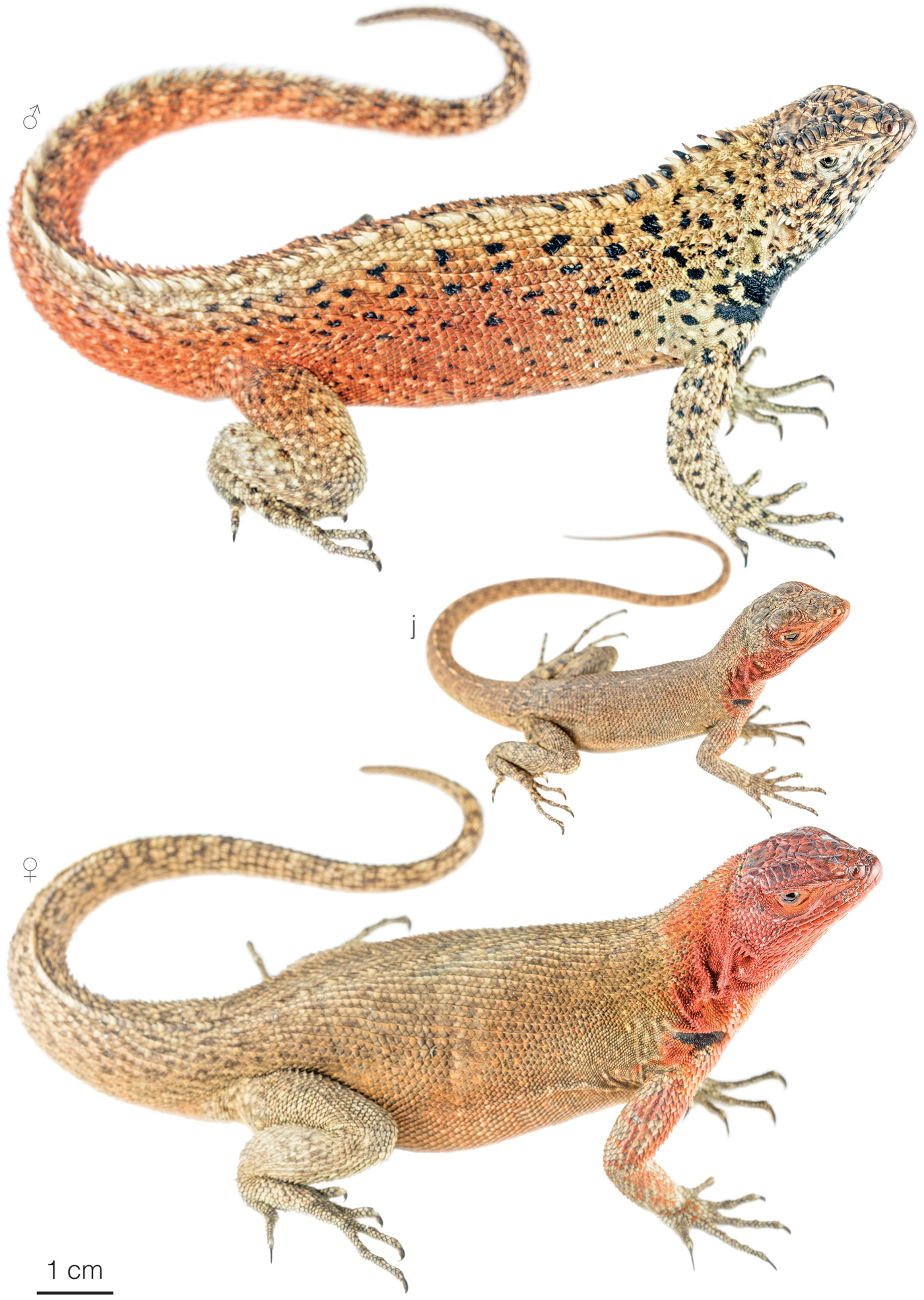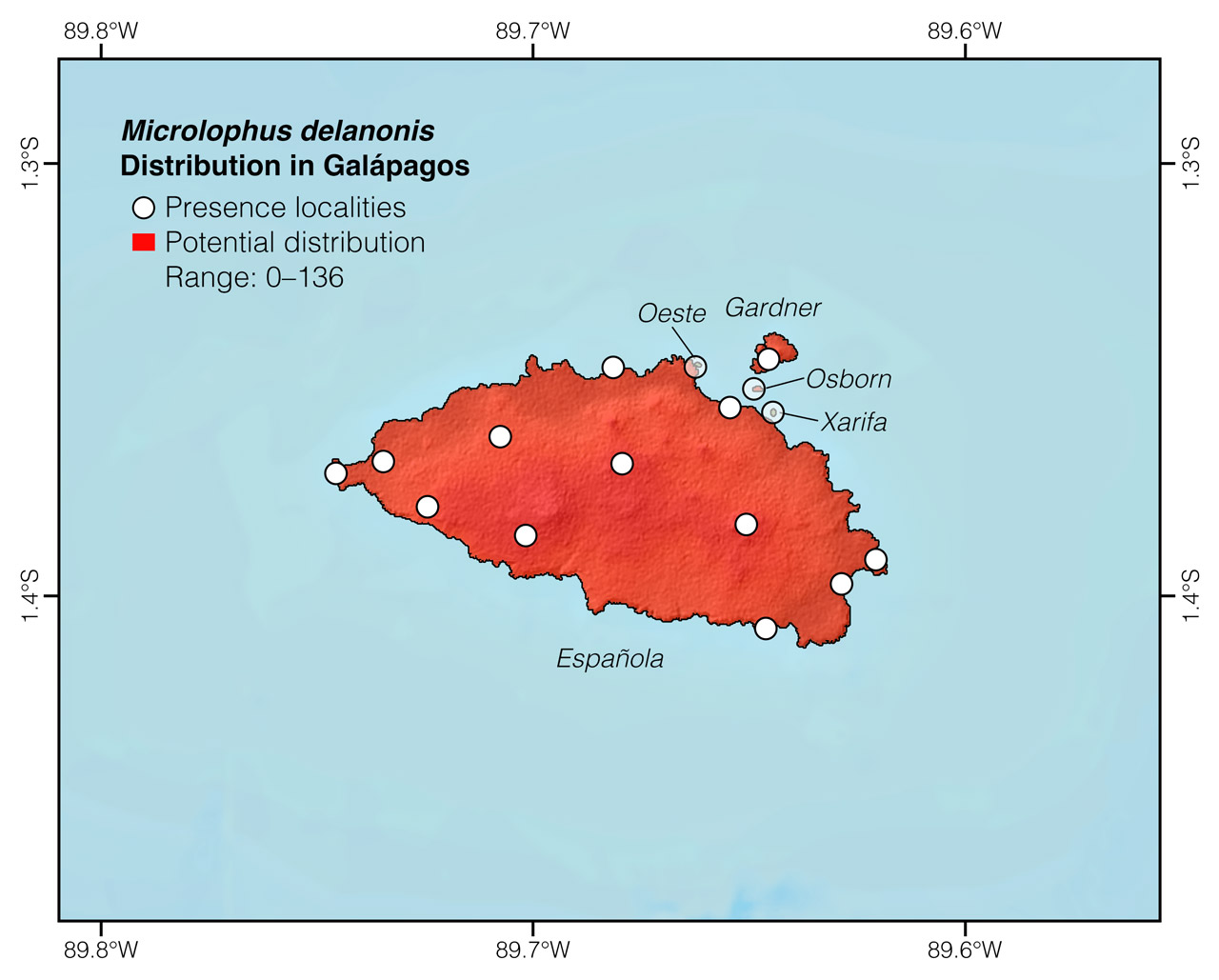Published October 10, 2019. Updated January 22, 2024. Open access. Peer-reviewed. | Purchase book ❯ |
Española Lava-Lizard (Microlophus delanonis)
Reptiles of Ecuador | Sauria | Tropiduridae | Microlophus delanonis
English common names: Española Lava-Lizard, Hood Lava-Lizard.
Spanish common names: Lagartija de lava de Española, lagartija de lava de Delano.
Recognition: ♂♂ 37.8 cmMaximum distance from the snout to the tip of the tail. Snout–vent length=13.3 cm. ♀♀ 27.4 cmMaximum distance from the snout to the tip of the tail. Snout–vent length=11.0 cm..1–4 Microlophus delanonis is easily distinguishable from other lizards occurring on Española Island (that is, iguanas and leaf-toed geckos) by having keeled scales on the tail, a skin fold above the shoulder, a raised mid-dorsal crest, and a conspicuously enlarged interparietal scale.1 This is the only lava lizard occurring on Española Island.1 Adult males are larger than females and easily recognized by their raised middorsal crest. They also have a reddish-brown body with scattered black blotches as well as a distinctive black throat.1–4 Adult females usually have a mostly uniform brownish body, bright orange face, and a black mark at shoulder level (Fig. 1).1–4

Figure 1: Individuals of Microlophus delanonis from Gardner Bay, Española Island, Galápagos, Ecuador. j=juvenile.
Natural history: Microlophus delanonis is a diurnal lizard that inhabits volcanic rock areas, dry shrublands, dry grasslands, and deciduous forests.1 During the early morning and late afternoon, Española Lava-Lizards utilize soil, rocks, shrubs, and cacti up to 3 m above the ground.1,2 To avoid the hottest hours of the day, they sit on branches or rocks that have not been heated by the sun.3 At sunset, they bury themselves under leaves or in soft soil, or retreat into crevices to spend the night.3 Their diet is generalist, and includes grasshoppers, moths, flies, beetles and their larvae, ants, spiders, caterpillars, scorpions, centipedes, seeds, berries, leaves, bird defecations, members of their own species, and even recently hatched finches.2,3 There are recorded instances of predation on members of this species, including by hawks, herons, mockingbirds, centipedes, and snakes (Pseudalsophis hoodensis).3 Reproduction peaks during the rainy season (December–May), with reproductive cycles lasting 3–4 weeks.3 Males patrol 250 m2 territories,3 which they defend by performing pushup displays and fighting with other males.1 Females move up to 200–300 m from their territories to find suitable nesting grounds.3 Here, they fight over nesting sites and lay 2–7 eggs4,5 in 10–45 cm deep nests excavated in sandy beaches, or in crevices 60 cm below the surface.3 Males can live up to 5.5 years, whereas females live up to 4.7 years.3
Conservation: Near Threatened Not currently at risk of extinction, but requires some level of management to maintain healthy populations..6 Microlophus delanonis is listed in this category because the species is, presumably, not undergoing population declines or facing major immediate threats of extinction.6 Española Island is not populated by humans or by exotic predators and is protected within the Galápagos National Park. However, since M. delanonis is restricted to a small island and its even smaller surrounding islets, the species could be seriously affected by random unpredictable events (like droughts and introduced species) within a short time period.1
Distribution: Microlophus delanonis is endemic to an area of approximately 61 km2 on Española Island and four of its surrounding islets (Gardner, Oeste, Osborn, and Xarifa). Galápagos, Ecuador (Figs 2, 3).

Figure 2: Distribution of Microlophus delanonis in Galápagos. See Appendix 1 for a complete list of the presence localities included in the map.

Figure 3: Distribution of Microlophus delanonis in Española Island. See Appendix 1 for a complete list of the presence localities included in the map.
Etymology: The generic name Microlophus comes from the Greek words mikros (=small) and lophos (=crest).1 The specific epithet delanonis honors captain Amasa Delano, a master mariner, shipbuilder, and author, who traveled in the Galápagos Islands and noted the existence of the Española Lava-Lizard.7
See it in the wild: Individuals of Microlophus delanonis can be seen year-round with complete certainty during tourism day trips to Española Island. The best time to look for and photograph Española Lava-Lizards is during the first hours after sunrise or right before sunset.
Special thanks to George Housley for symbolically adopting the Española Lava-Lizard and helping bring the Reptiles of Ecuador book project to life.
Click here to adopt a species.
Authors: Alejandro Arteaga,aAffiliation: Fundación Khamai, Reserva Arlequín, Ecoruta Paseo del Quinde km 56, Santa Rosa de Mindo, Pichincha 171202, Ecuador. Gabriela Aguiar,bIndependent researcher, Quito, Ecuador. and Juan M GuayasamincAffiliation: Universidad San Francisco de Quito, Quito, Ecuador.
Academic reviewers: Edgar Benavides,dAffiliation: Yale University, New Have, USA. John Rowe,eAffiliation: Alma College, Alma, USA. and Cruz MárquezfAffiliation: University of Rome Tor Vergata, Rome, Italy.
Photographer: Jose VieiragAffiliation: Tropical Herping (TH), Quito, Ecuador.,hAffiliation: ExSitu, Quito, Ecuador.
How to cite? Arteaga A, Aguiar G, Guayasamin JM (2024) Española Lava-Lizard (Microlophus delanonis). In: Arteaga A, Bustamante L, Vieira J (Eds) Reptiles of Ecuador: Life in the middle of the world. Available from: www.reptilesofecuador.com. DOI: 10.47051/LDDD4223
Literature cited:
- Arteaga A, Bustamante L, Vieira J, Tapia W, Guayasamin JM (2019) Reptiles of the Galápagos: life on the Enchanted Islands. Tropical Herping, Quito, 208 pp. DOI: 10.47051/AQJU7348
- Van Denburgh J, Slevin JR (1913) Expedition of the California Academy of Sciences to the Galápagos Islands, 1905-1906. IX. The Galapagoan lizards of the genus Tropidurus with notes on iguanas of the genera Conolophus and Amblyrhynchus. Proceedings of the California Academy of Sciences 2: 132–202.
- Werner DI (1978) On the biology of Tropidurus delanonis, Baur (Iguanidae). Zeitschrift für Tierpsychologie 47: 337–395. DOI: 10.1111/j.1439-0310.1978.tb01843.x
- Jordan MA, Snell HL (2002) Life history trade-offs and phenotypic plasticity in the reproduction of Galápagos lava lizards (Microlophus delanonis). Oecologia 130: 44–52.
- Carpenter CC (1970) Miscellaneous notes on Galápagos lava lizards (Tropidurus: Iguanidae). Herpetologica 26: 377–386.
- Cisneros-Heredia DF, Márquez C (2019) Microlophus delanonis. The IUCN Red List of threatened species. Available from: www.iucnredlist.org. DOI: 10.2305/IUCN.UK.2019-3.RLTS.T48444603A48444639.en
- Baur G (1890) Das Variieren der Eidechsen-Gattung Tropidurus auf den Galápagos Inseln und Bemerkungen über den Ursprung der Inselgruppe. Biologisches Centralblatt 10: 475–483.
Appendix 1: Locality data used to create the distribution map of Microlophus delanonis in Ecuador (Fig. 2). Go to the section on symbols and abbreviations for a list of acronyms used.
| Country | Province | Locality | Source |
| Ecuador | Galápagos | Bahía Gardner | Benavides et al. 2009 |
| Ecuador | Galápagos | Bahía Gardner, 2 km W of | Arteaga et al. 2019 |
| Ecuador | Galápagos | Bahía Gardner, 3 km S of | Arteaga et al. 2019 |
| Ecuador | Galápagos | Center of island | Arteaga et al. 2019 |
| Ecuador | Galápagos | Gardner islet | Baur 1890 |
| Ecuador | Galápagos | Islote Oeste | Benavides et al. 2009 |
| Ecuador | Galápagos | Meseta central | iNaturalist; photo examined |
| Ecuador | Galápagos | Osborn Islet | Benavides et al. 2009 |
| Ecuador | Galápagos | Punta Cevallos | Arteaga et al. 2019 |
| Ecuador | Galápagos | Punta Cevallos, 1 km N of | iNaturalist; photo examined |
| Ecuador | Galápagos | Punta Cevallos, 2 km W of | iNaturalist; photo examined |
| Ecuador | Galápagos | Punta Suárez | Arteaga et al. 2019 |
| Ecuador | Galápagos | Punta Suárez, 1 km E of | Arteaga et al. 2019 |
| Ecuador | Galápagos | Punta Suárez, 3 km SE of | iNaturalist; photo examined |
| Ecuador | Galápagos | Punta Suárez, 4 km E of | Arteaga et al. 2019 |
| Ecuador | Galápagos | Xarifa islet | Benavides et al. 2009 |